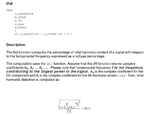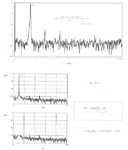ICdesignerbeginner
Member level 5
I want to find the THD of fully differential amplifier. I am using cadence virtuoso. I have found three options in simulating the THD in cadence which are:
1. using PSS analysis---- I select pss analysis then got ---direct plot --- forum forum then select voltage--- I place no. of harmonics i.e. 10 (I have kept)---fundamental frequency---select net as--differential and then select the two output nodes of my differential amplifier---It shows it in the form of 10 vertical straight lines because I have set the no. of harmonic as 10. I am taking the difference between the first harmonic and third harmonic which shows 58 dB.
2. Second option is I am doing transient analysis. On this transient response of the fully differential output I apply DFT fusing calculator and then take 20 dB---- I again get vertical lines as harmonics this time I get 53 dB which is the difference between first and third harmonic.
3. Third option is I have done transient analysis----apply THD using calculator ---take 20 dB--- This time it doesn't show waveform, it shows in form of numbers -10 dB, which I think is wrong.
I havent placed any port in my circuit The only source is the input sources of differential amplifiers. Which one is correct? Can anyone help.
i ALSO want to calculate SNR. There is no SNR option in calculator? Anyother way to find SNR?
1. using PSS analysis---- I select pss analysis then got ---direct plot --- forum forum then select voltage--- I place no. of harmonics i.e. 10 (I have kept)---fundamental frequency---select net as--differential and then select the two output nodes of my differential amplifier---It shows it in the form of 10 vertical straight lines because I have set the no. of harmonic as 10. I am taking the difference between the first harmonic and third harmonic which shows 58 dB.
2. Second option is I am doing transient analysis. On this transient response of the fully differential output I apply DFT fusing calculator and then take 20 dB---- I again get vertical lines as harmonics this time I get 53 dB which is the difference between first and third harmonic.
3. Third option is I have done transient analysis----apply THD using calculator ---take 20 dB--- This time it doesn't show waveform, it shows in form of numbers -10 dB, which I think is wrong.
I havent placed any port in my circuit The only source is the input sources of differential amplifiers. Which one is correct? Can anyone help.
i ALSO want to calculate SNR. There is no SNR option in calculator? Anyother way to find SNR?
Last edited:

